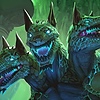HOME | DD
 Olmagon — The Persistence of the Ediacaran
Olmagon — The Persistence of the Ediacaran

#charnia #dickinsonia #parvancorina #proarticulata #yorgia #palaeophragmodictya #petalonamae #funisia #coronacollina #palaeoclassics #animal #classic #dali #digitalpainting #invertebrate #mollusk #paleoart #paleontology #precambrian #salvadordali #sponge #surrealart #surrealism #underwater #classicalpainting #ediacaran #paleoillustration #proterozoic #paleostream #prorifera
Published: 2022-03-19 01:22:14 +0000 UTC; Views: 17662; Favourites: 197; Downloads: 14
Redirect to original
Description
Drawing made for the #Palaeoclassics challenge being hosted on the Paleostream discord server (this one mobile.twitter.com/JoschuaKnup… ). The challenge is to recreate an existing pre-1990s artwork but with prehistoric animals as the focus, and I chose to recreate The Persistence of Memory by Salvador Dalí (or 'melting clocks' to people who don't know the real name of the painting) using a scene of Australia during the Ediacaran period, around 555 million years ago. The Ediacaran period is part of the Proterozoic Eon, before even the Paleozoic era and Cambrian period, and fossils dating to the Ediacaran are possibly the oldest known animal remains. Animals of this period are all marine, had mostly soft, squishy bodies without hard shells or bones and are so different from any living animals that most of them are still of uncertain placement on the tree of life. Ediacaran fauna was mostly small, often just centimeters long, though there are exceptions like giant Charnia and Dickinsonia remains found of individuals over a meter long. Animals portrayed in the picture are:Dickinsonia costata: the three oval-shaped creatures, one slithering down a rock, one on a Charnia frond and one climbing on some Funisia, replaces the melting watches in the original painting. These flat animals with rib-like segments and quite much no body parts we would recognize are among the most common animals found in Ediacaran deposits, and their fossils have been found in Australia, Russia, China, India and Ukraine. They range in size from millimeters to around 20 centimeters. Because the animal is so odd-looking its classification has long been a mystery, and it has been suggested to be related to worms, jellyfish, coral or sea anemones at various points. It has even been questioned whether these strange fossils were even those of animals, some suggesting they may be fungi or lichen, but more recent finds of cholesterol molecules in the fossils point towards it being one of the oldest known animals.
Dickinsonia rex: the huge blue flat oval thing a bit further back on the left, replaces what seems to be a metal sheet in Dalí's painting. Another species of the same genus as D. costata, this one is much bigger though, growing over a meter long, making it one of the largest Ediacaran animals. Whether this species is valid has been questioned though, some suggest they are simply oddly large individuals of D. costata.
Charnia masoni: the two animals resembling feathers or long leaves growing on the rock in the left (and one has a Dickinsonia on it), replaces the dead tree in the original painting. While they may look like plants and were also likely anchored to the ground, unable to move around like plants, the finds of some Charnia remains in deep water deposits which would have been in depths below what sunlight could reach (and thus photosynthesis couldn't occur) suggests these were animals. Size of Charnia specimens range from just 3 centimeters to almost 2 meters tall, though most were around 20 centimeters tall.
Yorgia waggoneri: the orangeish flat animal on the rock around the bottom left, replaces the watch covered with ants in the original. Like Dickinsonia it has rib-like segments, but unlike Dickinsonia it isn't perfectly symmetrical. The animal grows around 25 centimeters long.
Parvancorina minchami: the very small animal on top of the Dickinsonia furthest left, replaces the fly in the original painting. Vaguely triangular, the animal has a three-point ridge on its body and only grows 1 to 2 centimeters long. It has been suggested to be either a mollusk or arthropod bit this is still uncertain.
Funisia dorothea: the cluster of creatures that look like pillars of beads on the seabed in the center, replaces the weird object a clock is melting on in the original Dalí painting. Reaching 30 centimeters tall, this ancient animal grew in dense clusters anchored to the seabed of individuals around the same age, suggesting they reproduced via sexual reproduction. First described in 2008, it may be related to sponges of cnidarians.
Coronacollina acula: the animal with four long spines in the bottom right. This weird animal had a tiny central body, but four ridiculously long spikes sporting out of it, each 20 to 40 centimeters long. These spines were not soft and squishy like almost all other Ediacaran animals, but hardened with either chitin or minerals, making Coronacollina the oldest known animal to have hard body parts. It doesn't replace anything from Dalí's painting but I added it anyways because it is a neat weird creature that fits in with the whole surrealism theme.
Palaeophragmodictya reticulata: the yellow dome-shaped animals in the background around the top right, replaces the craggy cliffs in the original. For once we have an Ediacaran animal that can be confidently classed into a group, and this was an ancient species of sponge. Like modern sponges they even immobile and anchored to the seabed, and they reached heights of around 10 centimeters, filter-feeding on small particles.
Related content
Comments: 27

👍: 0 ⏩: 1

👍: 0 ⏩: 1

👍: 0 ⏩: 1

👍: 0 ⏩: 0

👍: 0 ⏩: 1

👍: 0 ⏩: 0

👍: 0 ⏩: 1

👍: 1 ⏩: 0

👍: 0 ⏩: 1

👍: 1 ⏩: 1

👍: 3 ⏩: 0

👍: 0 ⏩: 1

👍: 0 ⏩: 1

👍: 1 ⏩: 0

👍: 0 ⏩: 1

👍: 1 ⏩: 0

👍: 1 ⏩: 1

👍: 1 ⏩: 0

👍: 0 ⏩: 1

👍: 1 ⏩: 0

👍: 1 ⏩: 1

👍: 2 ⏩: 0

👍: 1 ⏩: 1

👍: 1 ⏩: 0
























